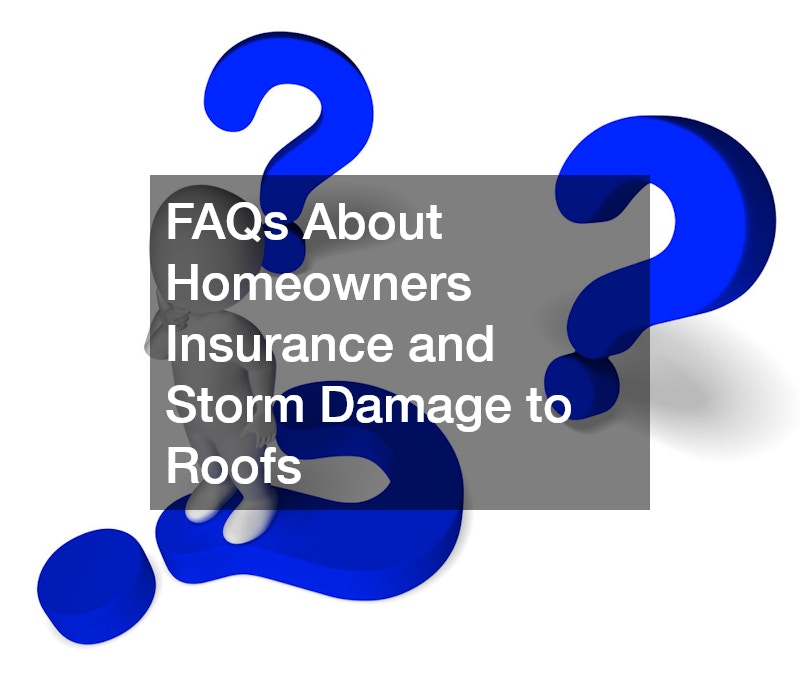
When a major storm hits, homeowners may be left wondering if their insurance policy will cover repairs or replacement for damage, especially to their roofs. Roofs bear the brunt of extreme weather, so understanding how homeowners insurance addresses storm damage can be a huge help. Here are answers to some of the most common questions about how homeowners insurance covers roof damage due to storms.
1. Does Homeowners Insurance Cover Roof Damage from Storms?
Generally, yes. Most standard homeowners insurance policies cover roof damage resulting from “perils” such as wind, hail, lightning, and fallen objects. However, coverage depends on the specifics of your policy and the type of storm damage incurred. Insurance companies typically cover sudden and accidental damage caused by storms, while they are unlikely to cover wear and tear or damage resulting from lack of maintenance.
2. What Types of Storm Damage Are Usually Covered?
Homeowners insurance typically covers various forms of storm damage, such as:
Wind damage: High winds can tear off shingles, dislodge gutters, and cause structural damage. If a windstorm or tornado damages your roof, insurance will likely cover repairs or replacements.
Hail damage: Many policies cover damage caused by hail, which can dent or crack roofing materials, especially shingles. However, in hail-prone areas, insurers may add a higher deductible for hail damage.
Fallen trees or debris: If a tree or other debris falls on your roof during a storm, the resulting damage is usually covered. Insurance may also cover tree removal, depending on the policy.
3. Are There Exclusions for Roof Damage?
Yes, certain types of roof damage may be excluded from coverage. Insurers may deny claims for:
Wear and tear: If your roof is old or poorly maintained, the insurer may attribute the damage to wear and tear, which is typically not covered.
Gradual deterioration: Over time, roofs will naturally degrade. Routine maintenance and minor repairs are the homeowner’s responsibility and are not covered by insurance.
Cosmetic damage: Some insurers may deny claims for damage deemed “cosmetic” rather than structural. For example, if hail dents a metal roof but doesn’t impact its functionality, the insurer may not cover repairs.
It’s important to review your policy or consult your agent to fully understand any exclusions that may apply to your roof.
4. What Are Actual Cash Value vs. Replacement Cost Policies?
There are two main types of coverage: actual cash value (ACV) and replacement cost. ACV policies cover the depreciated value of your roof, meaning you’ll receive the current worth of the roof, taking into account its age and condition. In contrast, replacement cost policies cover the cost to fully replace the roof at today’s prices without factoring in depreciation. Replacement cost policies are generally more expensive but offer broader protection, especially for older roofs.
5. How Does the Claims Process Work After Storm Damage?
When your roof is damaged by a storm, follow these steps to initiate a claim:
Document the damage: Take clear photos and notes of the damage immediately after the storm, as this will support your claim.
Prevent further damage: To avoid additional issues, cover any exposed areas temporarily with a tarp or other protective material. Not taking preventive steps can lead to claim denial.
Contact your insurer: Notify your insurance company as soon as possible and submit your documentation. They will likely send an adjuster to inspect the damage.
Get estimates: It can be helpful to get a repair or replacement estimate from a roofing contractor. Compare this with the insurance adjuster’s assessment to make sure the coverage aligns with your repair needs.
6. Is There a Deductible for Storm Damage Claims?
Yes, a deductible applies when you file a claim, and the amount will depend on your policy. Some insurers have a separate, higher deductible for certain storm types, particularly in areas prone to hurricanes or hail. It’s important to know your deductible amount before making a claim, as minor repairs may cost less than your deductible, making it unnecessary to file a claim.
Understanding how your homeowners insurance handles storm damage can save you both money and stress. By familiarizing yourself with your policy’s details, knowing what to expect from the claims process, and keeping up with regular maintenance, you’ll be better prepared to protect your roof and home after a storm. For specific guidance on your coverage, consult your insurance agent to ensure you’re adequately protected.





